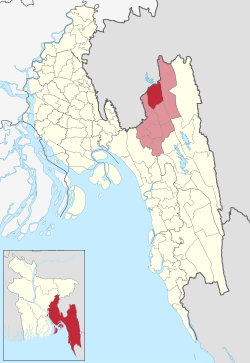Panchhari
পানছড়ি | |
|---|---|
 | |
| Coordinates: 23°17.4′N 91°54′E / 23.2900°N 91.900°E | |
| Country | |
| Division | Chittagong |
| District | Khagrachhari |
| Government | |
| • Bangladesh awami ligue | Mohammad Bahar |
| Area | |
| • Total | 334.10 km2 (129.00 sq mi) |
| Population (2011) | |
| • Total | 62,198 |
| • Density | 190/km2 (480/sq mi) |
| Time zone | UTC+6 (BST) |
| Postal code | 4410 |
| Website | Govt. official Site Official Map of Panchhari |
Panchhari (Bengali: পানছড়ি) is an upazila of Khagrachari District[1] in the Division of Chittagong, Bangladesh.
Geography
[edit]Panchhari is located at 23°17′25″N 91°54′00″E / 23.2903°N 91.9000°E. It has 14,154 households and total area 334.10 km2.
History
[edit]Panchhari is the site of a massacre by Shanti Bahini, the armed wing of the separtist Parbatya Chattagram Jana Samhati Samiti party in 1996.[2][3]
Demographics
[edit]As of the 2011 Bangladesh census, Panchhari upazila had 14,154 households and a population of 62,198. 14,095 (22.66%) were under 10 years of age. Panchhari had an average literacy rate of 42.3%, compared to the national average of 51.8%, and a sex ratio of 984 females per 1000 males. 22,706 (36.51%) of the population lived in urban areas.[4] The ethnic population was 41,797 (67.20%), of which Chakma were 28,302, Tripura 11,204 and Marma 1,917.[5]
As of the 1991 Bangladesh census, Panchhari has a population of 26,319. Males constitute 52.05% of the population, and females 47.95%. This Upazila's eighteen up population is 13,727. Panchhari has an average literacy rate of 25.4% (7+ years), and the national average of 32.4% literate.[6]
Administration
[edit]Panchhari Upazila is divided into five union parishads: Chengi, Latiban, Logang, Panchhari, and Ultachari. The union parishads are subdivided into 7 mauzas and 220 villages.[7]
Chairman: Sarbottom Chakma
Vice Chairman:
Woman Vice Chairman:
Upazila Nirbahi Officer (UNO):
See also
[edit]References
[edit]- ^ Sanjay Kishore Das (2012), "Panchhari Upazila", in Sirajul Islam and Ahmed A. Jamal (ed.), Banglapedia: National Encyclopedia of Bangladesh (Second ed.), Asiatic Society of Bangladesh
- ^ Correspondent, Our; Khagrachhari (2008-04-30). "Samo Adhiker demands punishment of culprits". The Daily Star. Retrieved 2023-04-20.
- ^ Refugees, United Nations High Commissioner for. "Refworld | Human Rights Situation". Refworld. Retrieved 2023-04-20.
- ^ a b "Bangladesh Population and Housing Census 2011 Zila Report – Khagrachhari" (PDF). bbs.gov.bd. Bangladesh Bureau of Statistics.
- ^ "Community Tables: Khagrachhari district" (PDF). bbs.gov.bd. Bangladesh Bureau of Statistics. 2011.
- ^ "Population Census Wing, BBS". Archived from the original on 2005-03-27. Retrieved November 10, 2006.
- ^ "District Statistics 2011: Khagrachhari" (PDF). Bangladesh Bureau of Statistics. Archived from the original (PDF) on 13 November 2014. Retrieved 14 July 2014.

Well, that’s interesting to know that Psilotum nudum are known as whisk ferns. Psilotum nudum is the commoner species of the two. While the P. flaccidum is a rare species and is found in the tropical islands. Both the species are usually epiphytic in habit and grow upon tree ferns. These species may also be terrestrial and grow in humus or in the crevices of the rocks.
View the detailed Guide of Psilotum nudum: Detailed Study Of Psilotum Nudum (Whisk Fern), Classification, Anatomy, Reproduction